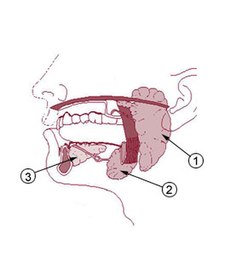Salivary gland neoplasm
human disease
Salivary gland cancer is a cancer that forms in tissues of a salivary gland. The salivary glands can be called major and minor.[1][2] The major salivary glands consist of the parotid, submandibular, and sublingual glands. The minor glands include small mucus-secreting glands located throughout the palate, nasal and oral cavity.[3] Salivary gland cancer is rare, with 2% of head and neck tumors forming in the salivary glands, the majority in the parotid.[4]
| Salivary gland cancer | |
|---|---|
| Classification and external resources | |
 The major salivary glands: the Parotid gland (1), where most salivary gland tumors form, the Submandibular gland (2), and the Sublingual gland (3). | |
| ICD-10 | C07.-C08., D11. |
| ICD-9 | 142, 210.2 |
| MedlinePlus | 001040 |
| MeSH | D012468 |
References
change- ↑ Laramore GE, Krall JM, Griffin TW, Duncan W, Richter MP, Saroja KR, Maor MH, Davis LW. Neutron versus photon irradiation for unresectable salivary gland tumors: final report of an RTOG-MRC randomized clinical trial. Int J Radiat Oncol Biol Phys. 1993 Sep 30;27(2):235-40.
- ↑ Krüll A, Schwarz R, Engenhart R, et al.: European results in neutron therapy of malignant salivary gland tumors. Bull Cancer Radiother 83 (Suppl): 125-9s, 1996
- ↑ Shah, p. 240
- ↑ Harari, p. 89